Sir Thomas Malory and #Arthurian #Legend ~ #kingarthur
"The hoole booke of kyng Arthur and of his noble knyghtes of the rounde table"
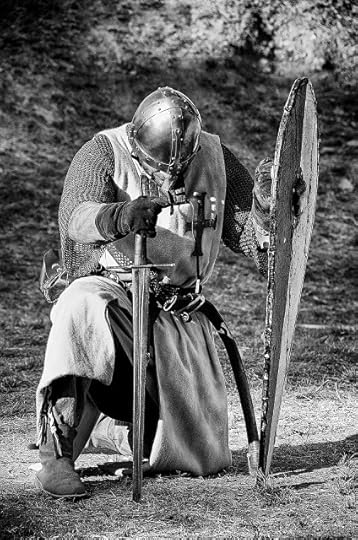
When it comes to the Great Arthurian writers, there are two names that come to mind — Geoffrey of Monmouth and Sir Thomas Malory. I have talked about Monmouth a lot recently, but I thought I would concentrate on Malory today.
Sir Thomas Malory gave us one of the greatest Arthurian works…
Le Morte d'Arthur.
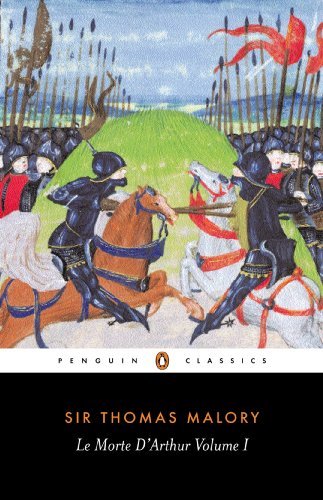
Le Morte d'Arthur was first published in 1485 and is now one of the best-known works of Arthurian literature. Many of the stories that were to follow, including the works of White and Tennyson, were strongly influenced by Malory's work.
Who was Sir Thomas Malory?
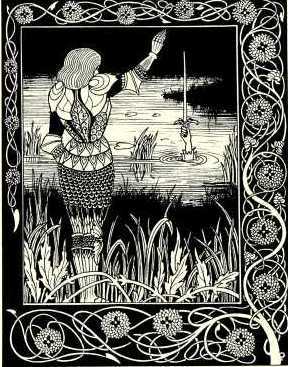 An Aubrey Beardsley illustration for Malory's Le Morte d'Arthur, "How Sir Bedivere Cast the Sword Excalibur into the Water" (1894) ~ Wikipedia
An Aubrey Beardsley illustration for Malory's Le Morte d'Arthur, "How Sir Bedivere Cast the Sword Excalibur into the Water" (1894) ~ WikipediaThat is a difficult question to answer because like King Arthur, Malory is pretty elusive. He did leave a small clue in the colophon of Le Morte d'Arthur. He called himself…
“Syr Thomas Maleore knyght.”He declares that he finished his work in the ninth year of the reign of Edward IV. He also leaves a prayer for “good delyueraunce” from prison.
The likeliest author of Le Morte d'Arthur is Thomas Malory of Newbold Revell in the parish of Monks Kirby, Warwickshire. This Sir Thomas had a rather notable career, for all the wrong reasons. He inherited his father's estate in 1434, but he didn't conform. He spent most of his life in and out of prison. His name has a long list of alleged crimes attached to it, theft, attempted murder, rape, extortion. He even escaped from Coleshill Prison, but instead of keeping a low profile, he robbed the Cistercian Monastery! He did, however, have friends in high places, for after two years lounging in prison, he was released through a Royal Pardon.
It is thought Malory was a Member of Parliament - why should that come as a surprise? And he may have fought in the Hundred Year War. He was knighted in 1441.
In 1460 Malroy was arrested yet again, but this time he was to serve his sentence in the notoriously harsh, Newgate Prison. There was to be no Royal Pardon this time. It was at this period in his life that he penned Le Morte d'Arthur.
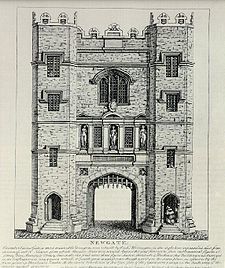 Newgate, the old city gate and prison ~ Wikipedia
Newgate, the old city gate and prison ~ WikipediaMalroy died in prison on 31 July 1485, and he was buried in the Chapel of St. Francis at Grey Friars. Le Morte d'Arthur was published posthumously by William Caxton.
Who was William Caxton?
William Caxton (c.1422 – c.1491) was an Englishman of many talents. He was a merchant, diplomat, translator, writer, and more importantly, William was a printer. William is renowned for bringing the printing press to England. In 1476, William printed his first books.
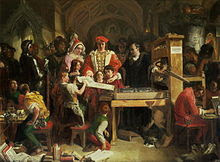 Caxton showing the first specimen of his printing to King Edward IV and Queen Elizabeth at the Almonry, Westminster (painting by Daniel Maclise) ~ Wikipedia
Caxton showing the first specimen of his printing to King Edward IV and Queen Elizabeth at the Almonry, Westminster (painting by Daniel Maclise) ~ WikipediaLe Morte d'Arthur became surprisingly popular and was reprinted many times over the centuries, although sometimes things were added into the works and likewise, things were taken out. Originally Malory umbrellaed eight books under Le Morte d'Arthur, but for some unfathomable reason, Coxton divided the original eight into 21, which makes a staggering 507 chapters!
I often wonder if Malory, while dying in prison, had any idea how influential his work would become.
***
If you fancy finding out what happened after the death of King Arthur then why not check out my historical fantasy series — The Du Lac Chronicles...

Amazon US
Amazon UK
Read for free with

Published on July 12, 2017 23:00
No comments have been added yet.
The Coffee Pot Book Club
The Coffee Pot Book Club (formally Myths, Legends, Books, and Coffee Pots) was founded in 2015. Our goal was to create a platform that would help Historical Fiction, Historical Romance and Historical
The Coffee Pot Book Club (formally Myths, Legends, Books, and Coffee Pots) was founded in 2015. Our goal was to create a platform that would help Historical Fiction, Historical Romance and Historical Fantasy authors promote their books and find that sometimes elusive audience. The Coffee Pot Book Club soon became the place for readers to meet new authors (both traditionally published and independently) and discover their fabulous books.
...more
...more
- Mary Anne Yarde's profile
- 159 followers



